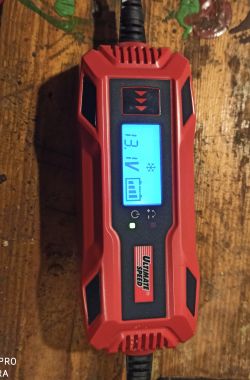FAQ
TL;DR: Charging current starts at 4.2–4.5 A and falls to ~3 A in minutes [Elektroda, user64, post #18990100]; “this is how it should be” [Elektroda, 78db78, post #18988541] Lidl’s 49.90 PLN charger cuts at 14.8 V then restarts [Elektroda, Cowboy zagrabie, #18988753].
Why it matters: Knowing the built-in limits helps you avoid under-charging or weeks-long wait times.
Quick Facts
• Price in store: 49.90 PLN [Elektroda, keseszel, post #18988459]
• Max charge voltage (auto mode): 14.8 V [Elektroda, Cowboy zagrabie, #18988753]
• Initial current on flat 12 V battery: 4.2–4.5 A, tapering to ≈3 A [Elektroda, user64, post #18990100]
• Full top-up of 100 Ah battery may take ~14 days [Elektroda, nomudrek, post #18990199]
• Mass-production cost estimate: 4 USD [Elektroda, 123nowy, post #19064276]
Why can’t I see any charging current or bubbling?
The charger shows current only for a few seconds after start, then switches to voltage display. It holds a fixed current until 14.8 V, pauses, and resumes after voltage falls to ~12.7 V, preventing visible gassing [Elektroda, Cowboy zagrabie, #18988753]. Bubbling therefore stays minimal even when charging properly.
How does the Lidl charger regulate current and voltage?
It begins at 4.2–4.5 A on deeply discharged batteries, drops to about 3 A within minutes, and keeps tapering as 14.5 V approaches [Elektroda, user64, post #18990100] When 14.8 V is reached, it shuts off and switches to a monitor cycle [Elektroda, Cowboy zagrabie, #18988753].
Will it fully charge large 100 Ah or 195 Ah batteries?
Yes, but slowly. Users needed nearly two weeks to reach correct density on a 100 Ah unit [Elektroda, nomudrek, post #18990199] A 195 Ah 6 V battery will take proportionally longer because current is limited to ≈4 A.
Is 14.8 V sufficient during winter?
Not always. Lead-acid chargers should raise voltage 0.03 V / °C below 25 °C. At −10 °C the target is about 15.6 V [Elektroda, Łukasz.K, #18992652]. Ca/Ca designs need up to 16.2 V at room temperature [Elektroda, tzok, post #18992690]
Does the battery need to gas to be 100 % charged?
Light gassing for a few minutes indicates full charge and helps dissolve residual sulphate [Elektroda, Łukasz.K, #18993514]. The Lidl charger avoids heavy boiling, yet may stop slightly early; topping off with a higher-voltage cycle can restore 3–4 % capacity.
Are the inexpensive 8-stage yellow chargers worth buying?
Mixed reviews. One user revived a deeply discharged battery that other smart chargers rejected [Elektroda, colin39, post #19064507] Another calls the multiple stages “marketing” [Elektroda, amator2000, post #18991809] Their real benefit is the higher equalization voltage many models offer (≈15.8 V).
Can raising voltage to 16 V desulphate a tired battery?
Yes. Increasing absorption voltage from 14.5 V to 15.8 V raised a sulphated 52 Ah battery’s measured capacity from 18 Ah to 40 Ah—a 122 % gain [Elektroda, tzok, post #18993622] "Higher voltage lets the plates shed sulphate" [Elektroda, tzok, post #18993622]
What does the Lidl unit likely cost to manufacture?
Forum estimates range from 4 USD [Elektroda, 123nowy, post #19064276] to 10 USD [Elektroda, tzok, post #19064261], reflecting component prices and mass-production scale.
Can I use the 6 V motorcycle mode to maintain a 6 V 195 Ah battery?
Yes. The charger will output a low 6 V current suitable for maintenance, but expect charging times measured in weeks due to the large capacity [Elektroda, user64, post #20431798]
How long should I leave the Lidl charger connected?
Its microprocessor cycles between charge and monitor, so indefinite float storage is safe. However, if voltage never rises above 13 V after days, disconnect and test the battery for faults [Elektroda, keseszel, post #19076293]
3-step: recovering a flat 12 V battery with the Lidl charger
- Select 12 V car mode and connect clamps firmly.
- Let the charger run until it first cuts off at 14.8 V (2–6 h).
- Leave connected overnight; it will cycle automatically until resting voltage holds above 12.6 V.
What edge cases or failures should I watch for?
A battery stuck at 12.6 V after week-long charging indicates sulphation or capacity loss [Elektroda, keseszel, post #19076293] Fully discharged batteries below 8 V may not start on rival smart chargers, but Lidl’s unit usually does [Elektroda, colin39, post #19064507]




